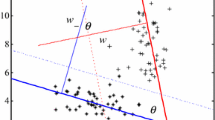Abstract
In this paper, we propose a novel nonparallel classifier, named sparse nonparallel support vector machine (SNSVM), for binary classification. Different with the existing nonparallel classifiers, such as the twin support vector machines (TWSVMs), SNSVM has several advantages: It constructs two convex quadratic programming problems for both linear and nonlinear cases, which can be solved efficiently by successive overrelaxation technique; it does not need to compute the inverse matrices any more before training; it has the similar sparseness with standard SVMs; it degenerates to the TWSVMs when the parameters are appropriately chosen. Therefore, SNSVM is certainly superior to them theoretically. Experimental results on lots of data sets show the effectiveness of our method in both sparseness and classification accuracy and, therefore, confirm the above conclusions further.






Similar content being viewed by others
References
Cortes C, Vapnik VN (1995) Support-vector networks. Mach Learn 20(3):273–297
Vapnik VN (1996) The nature of statistical learning theory. Springer, New York
Vapnik VN (1998) Statistical learning theory. Wiley, New York
Burges C (1998) A tutorial on support vector machines for pattern recognition. Data Min Knowl Discov 2:121–167
Trafalis TB, Ince H (2000) Support vector machine for regression and applications to financial forecasting. Proc IEEE-INNSENNS Int Joint Conf Neural Netw 6:348–353
Li S, Kwok JT, Zhu H, Wang Y (2003) Texture classification using the support vector machines. Pattern Recognit 36(12):2883–2893
Wu YC, Lee YS, Yang JC (2008) Robust and efficient multiclass svm models for phrase pattern recognition. Pattern Recognit 41(9):2874–2889
Isa D, Lee LH, Kallimani VP, RajKumar R (2008) Text document preprocessing with the bayes formula for classification using the support vector machine. IEEE Trans Knowl Data Eng 20(9):1264–1272
Karsten MB (2011) Kernel methods in bioinformatics. Handb Stat Bioinform Part 3:317–334
Wang XY, Wang T, Bu J (2011) Color image segmentation using pixel wise support vector machine classification. Pattern Recognit 44(4):777–787
Khan N, Ksantini R, Ahmad I, Boufama B (2012) A novel svm+nda model for classification with an application to face recognition. Pattern Recognit 45(1):66–79
Mangasarian OL, Wild EW (2006) Multisurface proximal support vector classification via generalized eigenvalues. IEEE Trans Pattern Anal Mach Intell 28(1):69–74
Jayadeva RK, Khemchandani R, Chandra S (2007) Twin support vector machines for pattern classification. IEEE Trans Pattern Anal Mach Intell 29(5):905–910
Kumar MA, Gopal M (2008) Application of smoothing technique on twin support vector machines. Pattern Recognit Lett 29(13):1842–1848
Khemchandani R, Jayadeva RK, Chandra S (2009) Optimal kernel selection in twin support vector machines. Optim Lett 3(1):77–88
Kumar MA, Gopal M (2009) Least squares twin support vector machines for pattern classification. Expert Syst Appl 36(4):7535–7543
Shao YH, Zhang CH, Wang XB, Deng NY (2011) Improvements on twin support vector machines. IEEE Trans Neural Netw 22(6):962–968
Peng XJ (2010) Tsvr: An efficient twin support vector machine for regression. Neural Netw 23(3):365–372
Chen X, Yang J, Ye Q, Liang J (2011) Recursive projection twin support vector machine via within-class variance minimization. Pattern Recognit. doi:10.1016/j.patcog.2011.03.001
Mangasarian OL (1994) Nonlinear programming. SIAM, Philadelphia
Mangasarian OL, Musicant DR (1999) Successive overrelaxation for support vector machines. IEEE Trans Neural Netw 10(5):1032–1037
Platt J (2000) Fast training of support vector machines using sequential minimal optimization. In: Schölkopf B, Burges CJC, Smola AJ (eds) Advances in Kernel methods—support vector learning. MIT Press, Cambridge
Blake CL, Merz CJ (1998) Uci repository for machine learning databases. Department of Information and Computer Science, University of California. Irvine [Online], Available: http://archive.ics.uci.edu/ml/datasets.html
Joachims T (2000) Estimating the generalization performance of an svm efficiently. In: Proceedings of international conference on machine learning, Morgan Kaufmann, San Franscisco, pp 431–438
Vapnik VN, Chapelle O (2000) Bounds on error expectation for svm. In: Advances in large-margin classifiers, neural information processing, MIT press, Cambridge, pp 261–280
Adankon MM, Cheriet M, Biem A (2009) Semisupervised least squares support vector machine. IEEE Trans Neural Netw 20(12):1858–1870
Acknowledgments
This work has been partially supported by grants from National Natural Science Foundation of China (No. 11271361, No. 70921061), the CAS/SAFEA International Partnership Program for Creative Research Teams, Major International (Ragional) Joint Research Project (No. 71110107026), the President Fund of GUCAS.
Author information
Authors and Affiliations
Corresponding author
Rights and permissions
About this article
Cite this article
Tian, Y., Ju, X. & Qi, Z. Efficient sparse nonparallel support vector machines for classification. Neural Comput & Applic 24, 1089–1099 (2014). https://doi.org/10.1007/s00521-012-1331-5
Received:
Accepted:
Published:
Issue Date:
DOI: https://doi.org/10.1007/s00521-012-1331-5




